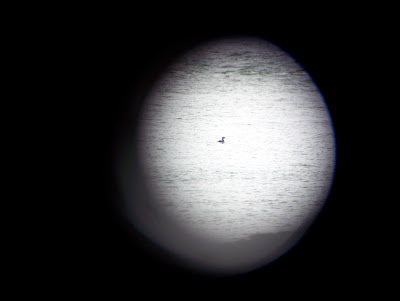Yup. That was a Blue Grosbeak (Passerina caerulea). Congrats to Julia for her correct ID.
No one got the bird in the dark correct (it is not a verdin, great kiskadee, or black-capped chickadee), so I've decided to give everyone a second week to answer that one. Here are a few hints regarding that particular bird:
1. It is comparable to a northern cardinal in size
2. The area it is in has a few trees, but most of the habitat is scrub
Answers for the bird in the dark are due on November 19th.
Now get out those field guides and raincoats, because we're heading out to dreary shores of Garibaldi, Oregon for a waterbird extravaganza! It's time for...
The Coastal Challenge
That's right... 5 photos, 7 species, and only 3 weeks to identify them all!But first, some general info on birding by the sea.
Coastal areas are perhaps the best places for birding, especially in lagoons, tidal marshes, bays, and jetties. You can find hundreds of species in the same place: ducks, geese, grebes, loons, herons, sandpipers, plover, cormorants, pelicans, rails, falcons, eagles, gulls, terns, skuas, murres, auks, puffins, pipits, sparrows, blackbirds--the list goes on and on. Best of all, they tend to be out in the open and fairly easy to see (there's not much to hide them on the open water or along the shore).
One of the best things for beginners about birds along the coast is that their daily schedule is not governed by the sun. For warblers and other migratory forest birds, you pretty much have to go birding really early in the morning to see them. Seabirds and shorebirds, however, go by the tides. You can go to a tidal marsh or jetty at high tide and it will be filled with diving ducks and grebes; if you visit the same location at low tide, the ducks will be gone and replaced with sandpipers and plover. If you are on vacation to the coast, consider visiting a beach near a wildlife refuge. Pay attention to the birds that fly by--not everything is a gull! In southern California you can find lots of terns, cormorants, pelicans, and sometimes even skimmers at popular state beaches.
There are two problems with birding near the ocean:
1. We don't have any around here.
2. Waterbirds can be tough because of how far away they are from shore.
On that note, you'll have to use all of your birding ability to get these ID's. When you post your answers, identify which picture they go with. Remember, in order to get full points you must identify the species, not just family or genus. Ready? Have fun!
#1: Perched on a shipwreck near a clam processing plant...
 |
| Photo by the author. |
 |
| Photo by the author. |
 |
| Photo by the author. |
 |
| Photo by the author. |
 |
| Photo by the author. |
Answers for the Coastal Challenge are due by Monday, December 10th.
(Yeah, I extended it again. Again.)
Happy identification!
#1: Black Turnstone
ReplyDeleteI'll be back for the rest later...
#4 I think I know! That's a loon, right? I'm going to say Gavia immer, the Great Northern Loon.
ReplyDeleteThe rest will require a physical bird book, so I'll leave a new comment later.
Excellent challenge, Arch. Good luck, all you aspiring birders. I'll leave the identifications to you...
ReplyDeleteThese look like... birds.
ReplyDeleteOR
Please avail one of your bird catalogs to me so that I may identify the ones in your photos.
Here are my best shots.
Delete1. Eared Grebes
2. Horned Grebe (center)
4. Eared Grebe (bottom center)
For the past few weeks I have glanced at this challenge and decided to take on this immense challenge at some later point in time. Now that I finally have a field guide, I can say that this challenge was pretty difficult. There are so many types of coastal birds and it was pretty hard deciding which ones to guess.
ReplyDeleteMy guesses are:
1. Piping Plover...
2. Black-bellied Plover and Red Phalarope
3. Hudsonian Godwit (I have no idea what this is)
4. Some sort of sandpiper?
It was difficult and I failed but I gave it a shot. I apologize to all professional birders for this failure.